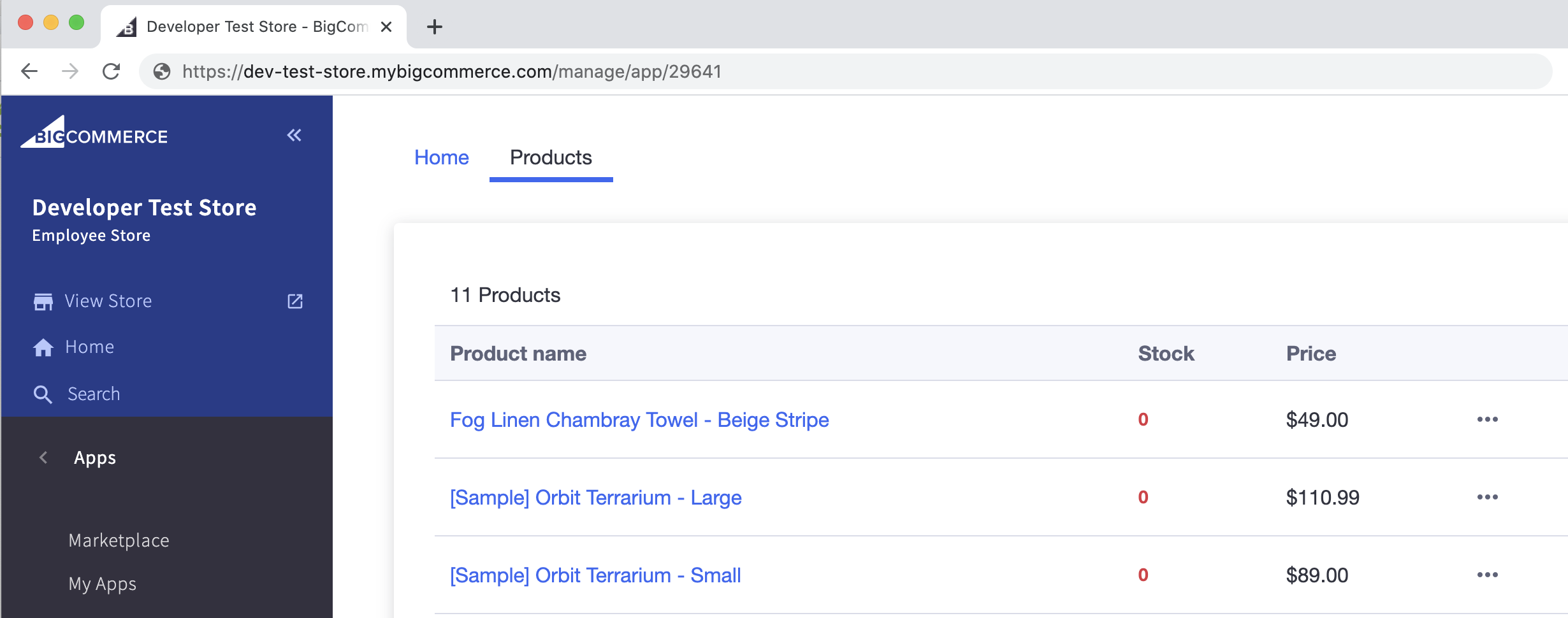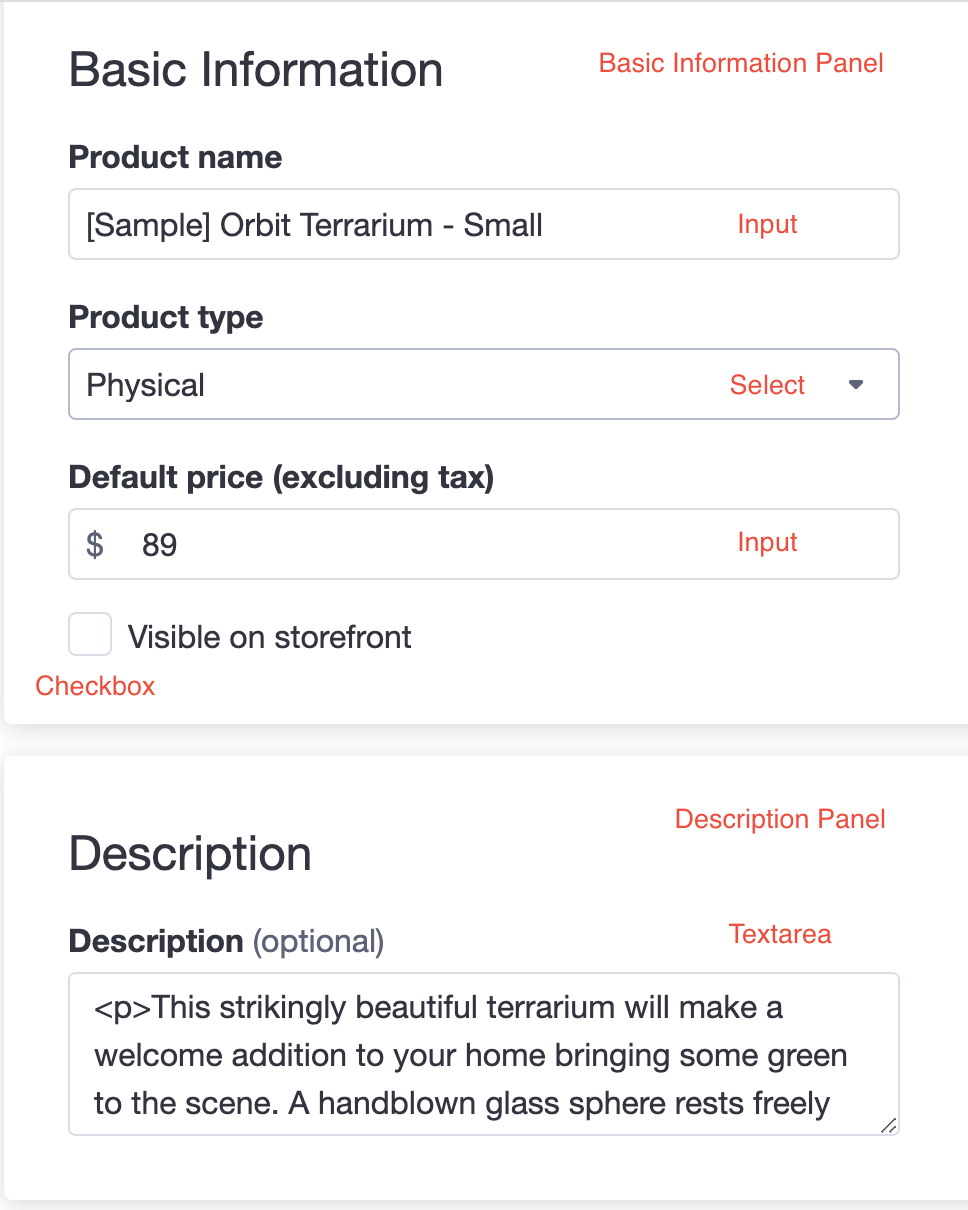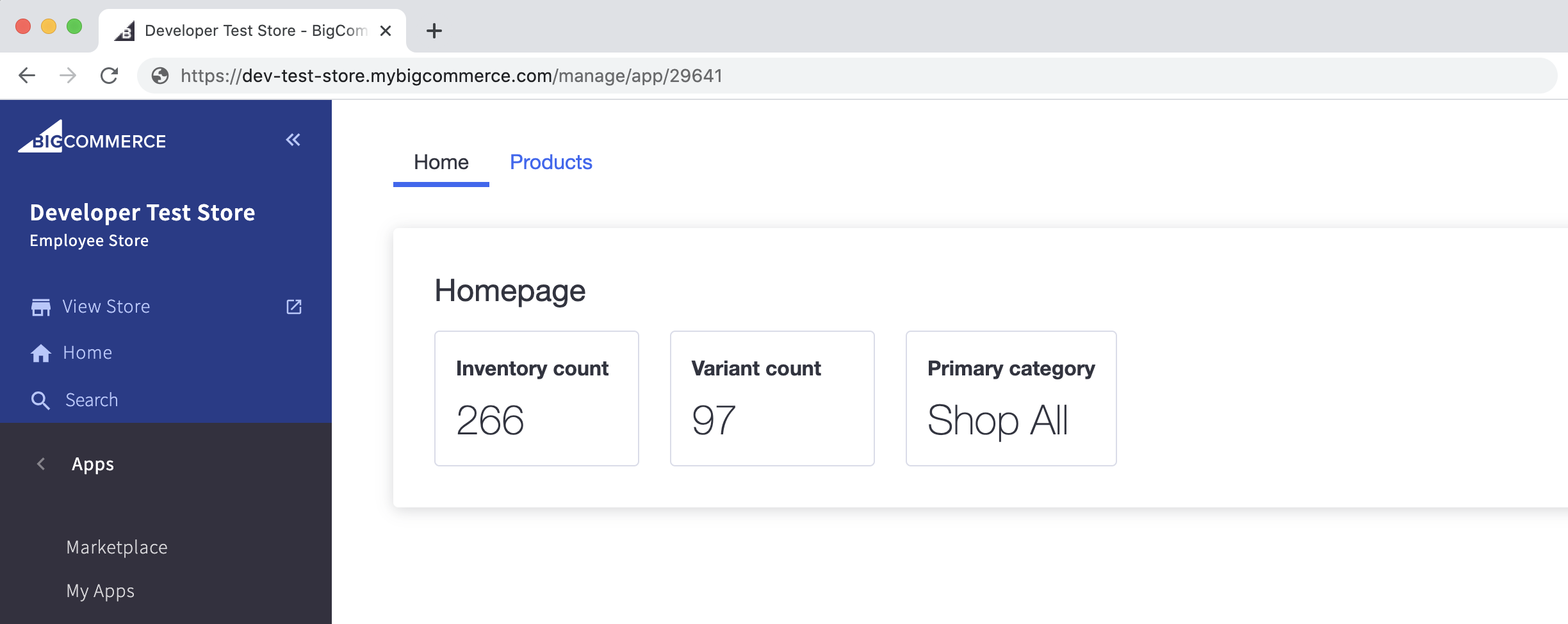Step 4: Enhance the User Experience with BigDesign
BigDesign (opens in a new tab) plays a pivotal part in the BigCommerce control panel and ecosystem. App developers are encouraged to use BigDesign to develop apps that have a native BigCommerce look and feel.
This step focuses on expanding functionality and integrating advanced design elements available as part of the BigDesign library.
Create the Products List route
-
From the
pages/apifolder, open theproductsfolder. -
In the
productsfolder, create alist.tsfile. Thelist.tsfile will be routed to/api/listand treated as an API endpoint, instead of a regular component. -
At the top of the file, import the following packages:
import { NextApiRequest, NextApiResponse } from 'next';
import { bigcommerceClient, getSession } from '../../../lib/auth';- Add the logic to call the Products endpoint of BigCommerce's Catalog API. You can view list.ts (GitHub) (opens in a new tab).
export default async function list(req: NextApiRequest, res: NextApiResponse) {
try {
const { accessToken, storeHash } = await getSession(req);
const bigcommerce = bigcommerceClient(accessToken, storeHash);
// Optional: pass in API params here
const params = new URLSearchParams({ limit: '11' }).toString();
const { data } = await bigcommerce.get(`/catalog/products?${params}`);
res.status(200).json(data);
} catch (error) {
const { message, response } = error;
res.status(response?.status || 500).json({ message });
}
}Update custom hooks
-
In the
libfolder, open thehooks.tsfile. -
Add the
isLoadingproperty to theuseProductscustom hook.
export function useProducts() {
const encodedContext = useSession()?.context;
// Request is deduped and cached; Can be shared across components
const { data, error } = useSWR(encodedContext ? ['/api/products', encodedContext] : null, fetcher);
return {
summary: data,
isLoading: !data && !error,
isError: error,
};
}- Add the
useProductListcustom hook. You can view hooks.ts (GitHub) (opens in a new tab).
export function useProductList() {
const encodedContext = useSession()?.context;
// Use an array to send multiple arguments to fetcher
const { data, error, mutate: mutateList } = useSWR(encodedContext ? ['/api/products/list', encodedContext] : null, fetcher);
return {
list: data,
isLoading: !data && !error,
isError: error,
mutateList,
};
}Create the Products page
-
In the
pagesfolder, create aproductsfolder. -
In the
productsfolder, create anindex.tsxfile. -
At the top of the file, import the following packages:
import { Button, Dropdown, Panel, Small, StatefulTable, Link as StyledLink } from '@bigcommerce/big-design';
import { MoreHorizIcon } from '@bigcommerce/big-design-icons';
import Link from 'next/link';
import { useRouter } from 'next/router';
import { ReactElement } from 'react';
import { useProductList } from '../../lib/hooks';- Add the
Productsfunctional component. TheProductscomponent uses the BigDesign's StatefulTable (opens in a new tab), a wrapper of the Table (opens in a new tab) component that supports pagination, row selection, and sorting. You can view index.tsx (GitHub) (opens in a new tab).
const Products = () => {
const router = useRouter();
// Retrieve data from the catalog/products endpoint
const { isError, isLoading, list = [] } = useProductList();
// Properly format data for BigDesign's StatefulTable
const tableItems = list.map(({ id, inventory_level: stock, name, price }) => ({
id,
name,
price,
stock,
}));
// When rendering table headers, you can return a string or a React component:
const renderName = (id: number, name: string): ReactElement => (
<Link href={`/products/${id}`}>
<StyledLink>{name}</StyledLink>
</Link>
);
const renderPrice = (price: number): string => (
new Intl.NumberFormat('en-US', { style: 'currency', currency: 'USD' }).format(price)
);
const renderStock = (stock: number): ReactElement => (stock > 0
? <Small>{stock}</Small>
: <Small bold marginBottom="none" color="danger">0</Small>
);
const renderAction = (id: number): ReactElement => (
<Dropdown
items={[ { content: 'Edit product', onItemClick: () => router.push(`/products/${id}`), hash: 'edit' } ]}
toggle={<Button iconOnly={<MoreHorizIcon color="secondary60" />} variant="subtle" />}
/>
);
return (
<Panel>
<StatefulTable
columns={[
{ header: 'Product name', hash: 'name', render: ({ id, name }) => renderName(id, name), sortKey: 'name' },
{ header: 'Stock', hash: 'stock', render: ({ stock }) => renderStock(stock), sortKey: 'stock' },
{ header: 'Price', hash: 'price', render: ({ price }) => renderPrice(price), sortKey: 'price' },
{ header: 'Action', hideHeader: true, hash: 'id', render: ({ id }) => renderAction(id), sortKey: 'id' },
]}
items={tableItems}
itemName="Products"
stickyHeader
/>
</Panel>
);
};
export default Products;Add the InnerHeader component
-
In the
componentsfolder, create aninnerHeader.tsxfile. -
At the top of the file, import the following packages:
import { Box, Button, H1, HR, Text } from '@bigcommerce/big-design';
import { ArrowBackIcon } from '@bigcommerce/big-design-icons';
import { useRouter } from 'next/router';
import { useProductList } from '../lib/hooks';
import { TabIds, TabRoutes } from './header';- Define the
InnerHeaderfunctional component. You use it for the Product Edit page, a subpage ofproducts(/products/[pid]), whereas the mainHeadercomponent is used for the main pages such as/and/products. You can view innerHeader.tsx (GitHub) (opens in a new tab).
const InnerHeader = () => {
const router = useRouter();
const { pid } = router.query;
const { list = [] } = useProductList();
const { name } = list.find(item => item.id === Number(pid)) ?? {};
const handleBackClick = () => router.push(TabRoutes[TabIds.PRODUCTS]);
return (
<Box marginBottom="xxLarge">
<Button iconLeft={<ArrowBackIcon color="secondary50" />} variant="subtle" onClick={handleBackClick}>
<Text bold color="secondary50">Products</Text>
</Button>
{name &&
<H1>{name}</H1>
}
<HR color="secondary30" />
</Box>
);
};
export default InnerHeader;The InnerHeader component uses BigDesign's Button component with the variant property set to subtle. By setting the variant type to subtle, you remove the button's border and simultaneously add a hover effect. To learn more about the BigDesign's Button component, see Buttons Design Guidelines (opens in a new tab).
The ArrowBackIcon component is part of the BigDesign's Icons package. You can modify the look of the icon by setting its color and size. To learn more about BigDesign's Icons, see Icons (opens in a new tab).
Update the Header component
In this step, you incorporate the BigDesign's Tabs component into your app. You use the Tabs component to organize and navigate between content types. To learn more, see Tabs Developer Docs (opens in a new tab).
- In the components folder, open the
header.tsxfile and update the imports.
import { Box, Tabs } from '@bigcommerce/big-design';
import { useRouter } from 'next/router';
import { useEffect, useState } from 'react';
import InnerHeader from './innerHeader';- Declare
TabIds,TabRoutes,InnerRoutes, andHeaderTypesvariables.
export const TabIds = {
HOME: 'home',
PRODUCTS: 'products',
};
export const TabRoutes = {
[TabIds.HOME]: '/',
[TabIds.PRODUCTS]: '/products',
};
const InnerRoutes = [
'/products/[pid]',
];
const HeaderTypes = {
GLOBAL: 'global',
INNER: 'inner',
};- Update the
Headerfunctional component. You can view header.tsx (GitHub) (opens in a new tab).
const Header = () => {
const [activeTab, setActiveTab] = useState<string>('');
const [headerType, setHeaderType] = useState<string>(HeaderTypes.GLOBAL);
const router = useRouter();
const { pathname } = router;
useEffect(() => {
if (InnerRoutes.includes(pathname)) {
// Use InnerHeader if route matches inner routes
setHeaderType(HeaderTypes.INNER);
} else {
// Check if new route matches TabRoutes
const tabKey = Object.keys(TabRoutes).find(key => TabRoutes[key] === pathname);
// Set the active tab to tabKey or set no active tab if route doesn't match (404)
setActiveTab(tabKey ?? '');
setHeaderType(HeaderTypes.GLOBAL);
}
}, [pathname]);
useEffect(() => {
// Prefetch products page to reduce latency (doesn't prefetch in dev)
router.prefetch('/products');
});
const items = [
{ id: TabIds.HOME, title: 'Home' },
{ id: TabIds.PRODUCTS, title: 'Products' },
];
const handleTabClick = (tabId: string) => {
setActiveTab(tabId);
return router.push(TabRoutes[tabId]);
};
if (headerType === HeaderTypes.INNER) return <InnerHeader />;
return (
<Box marginBottom="xxLarge">
<Tabs
activeTab={activeTab}
items={items}
onTabClick={handleTabClick}
/>
</Box>
);
};
export default Header;The Header functional component uses the useEffect React hook to perform side effects and enhance performance. Notably, performance enhancement is only visible in a production or production-like environment (integration or staging). router.prefetch() does not prefetch the products page while in the development mode.
Test your app
Your app should now display two tabs: Home and Products. Click on the Products tab. You should see a list of products from your test store.

Latency
When loading the products page for the first time, the latency you notice only happens in the development mode. In production or a production-like environment, router.prefetch() prefetches the products page reducing the latency.
To test your app in a production or a production-like environment (integration or staging), run npm run build instead of npm run dev in your terminal. This builds and compiles your local code. Then, run npm run start to get the performance enhancements traditionally not available in the development mode.
Keep in mind that any changes you make to your code after running npm run build need to go through the build process to be captured.
Create the ErrorMessage component
To surface error messages to the app's users, add an error message component. You can call this component from any page or component.
-
In the
componentsfolder, add theerror.tsxfile. -
Copy and paste the following code to create the
ErrorMessagecomponent. You can view error.tsx (GitHub) (opens in a new tab).
import { H3, Panel } from '@bigcommerce/big-design';
interface ErrorMessageProps {
error?: Error;
}
const ErrorMessage = ({ error }: ErrorMessageProps) => (
<Panel>
<H3>Failed to load</H3>
{error && error.message}
</Panel>
);
export default ErrorMessage;Create the Loading component
The Loading component makes use of the BigDesign's indeterminant ProgressCircle indicator. The indeterminant ProgressCircle (opens in a new tab) represents an unknown amount of time for a task to complete. To learn more about BigDesign's progress indicators, see Progress Circle Developer Docs (opens in a new tab).
In the components folder, create a loading.tsx file. You can view loading.tsx (GitHub) (opens in a new tab).
import { Flex, H3, Panel, ProgressCircle } from '@bigcommerce/big-design';
const Loading = () => (
<Panel>
<H3>Loading...</H3>
<Flex justifyContent="center" alignItems="center">
<ProgressCircle size="large" />
</Flex>
</Panel>
);
export default Loading;Add system checks
Now that you have created the ErrorMessage and Loading components, you can add them to the Products component.
-
In the
/pages/productsfolder, open theindex.tsxfile. -
Import the
ErrorMessageandLoadingcomponents.
import ErrorMessage from '../../components/error';
import Loading from '../../components/loading';- Inside the
Productsfunctional component, above thereturnstatement, add the logic to returnErrorMessageandLoadingcomponents.isLoadingchecks when the page or component is loading andisErrorchecks for API errors. You can view index.tsx (GitHub) (opens in a new tab).
if (isLoading) return <Loading />;
if (isError) return <ErrorMessage />;Update TypeScript definitions
-
In the
typesfolder, open thedata.tsfile. -
Export
FormDataandStringKeyValueTypeScript definitions. You can view data.ts (GitHub) (opens in a new tab).
export interface FormData {
description: string;
isVisible: boolean;
name: string;
price: number;
type: string;
}
export interface StringKeyValue {
[key: string]: string;
}Create the Form component
You use the BigDesign's Form component to display and edit individual product information.
The BigDesign's Form component comes with built-in support for accessibility, validation, and handling errors. It supports various input types, including Input, Checkbox, Radio, Select, and Textarea. To learn more, see Form Developer Docs (opens in a new tab).
-
In the
componentsfolder, add theform.tsxfile. -
At the top of the file, import the following packages:
import { Button, Checkbox, Flex, FormGroup, Input, Panel, Select, Form as StyledForm, Textarea } from '@bigcommerce/big-design';
import { ChangeEvent, FormEvent, useState } from 'react';
import { FormData, StringKeyValue } from '../types';- Add the
FormPropsTypeScript definition.
interface FormProps {
formData: FormData;
onCancel(): void;
onSubmit(form: FormData): void;
}- Declare the
FormErrorsvariable.
const FormErrors = {
name: 'Product name is required',
price: 'Default price is required',
};- Declare and export the
Formfunctional component. You can view form.tsx (GitHub) (opens in a new tab).
const Form = ({ formData, onCancel, onSubmit }: FormProps) => {
const { description, isVisible, name, price, type } = formData;
const [form, setForm] = useState<FormData>({ description, isVisible, name, price, type });
const [errors, setErrors] = useState<StringKeyValue>({});
const handleChange = (event: ChangeEvent<HTMLInputElement | HTMLTextAreaElement>) => {
const { name: formName, value } = event?.target;
setForm(prevForm => ({ ...prevForm, [formName]: value }));
// Add error if it exists in FormErrors and the input is empty, otherwise remove from errors
!value && FormErrors[formName]
? setErrors(prevErrors => ({ ...prevErrors, [formName]: FormErrors[formName] }))
: setErrors(({ [formName]: removed, ...prevErrors }) => ({ ...prevErrors }));
};
const handleSelectChange = (value: string) => {
setForm(prevForm => ({ ...prevForm, type: value }));
};
const handleCheckboxChange = (event: ChangeEvent<HTMLInputElement>) => {
const { checked, name: formName } = event?.target;
setForm(prevForm => ({ ...prevForm, [formName]: checked }));
};
const handleSubmit = (event: FormEvent<EventTarget>) => {
event.preventDefault();
// If there are errors, do not submit the form
const hasErrors = Object.keys(errors).length > 0;
if (hasErrors) return;
onSubmit(form);
};
return (
<StyledForm onSubmit={handleSubmit}>
<Panel header="Basic Information">
<FormGroup>
<Input
error={errors?.name}
label="Product name"
name="name"
required
value={form.name}
onChange={handleChange}
/>
</FormGroup>
<FormGroup>
<Select
label="Product type"
name="type"
options={[
{ value: 'physical', content: 'Physical' },
{ value: 'digital', content: 'Digital' }
]}
required
value={form.type}
onOptionChange={handleSelectChange}
/>
</FormGroup>
<FormGroup>
<Input
error={errors?.price}
iconLeft={'$'}
label="Default price (excluding tax)"
name="price"
placeholder="10.00"
required
type="number"
step="0.01"
value={form.price}
onChange={handleChange}
/>
</FormGroup>
<FormGroup>
<Checkbox
name="isVisible"
checked={form.isVisible}
onChange={handleCheckboxChange}
label="Visible on storefront"
/>
</FormGroup>
</Panel>
<Panel header="Description">
<FormGroup>
{/* Using description for demo purposes. Consider using a wysiwig instead (e.g. TinyMCE) */}
<Textarea
label="Description"
name="description"
placeholder="Product info"
value={form.description}
onChange={handleChange}
/>
</FormGroup>
</Panel>
<Flex justifyContent="flex-end">
<Button
marginRight="medium"
type="button"
variant="subtle"
onClick={onCancel}
>
Cancel
</Button>
<Button type="submit">Save</Button>
</Flex>
</StyledForm>
);
};
export default Form;Create dynamic product routes
Next.js allows you to create dynamic routes by adding brackets to a page; for example, [pid]. Any route similar to products/123 or products/abc is matched by pages/products/[pid].tsx. To learn more about defining dynamic routes in Next.js, see Dynamic Routes (opens in a new tab).
-
Navigate to the
/pages/productsfolder and create a[pid].tsxfile. -
At the top of the file, import the following packages:
import { useRouter } from 'next/router';
import ErrorMessage from '../../components/error';
import Form from '../../components/form';
import Loading from '../../components/loading';
import { useSession } from '../../context/session';
import { useProductList } from '../../lib/hooks';
import { FormData } from '../../types';- Declare and export the
ProductInfofunctional component. You can view [pid].tsx (GitHub) (opens in a new tab).
const ProductInfo = () => {
const router = useRouter();
const encodedContext = useSession()?.context;
const { pid } = router.query;
const { isError, isLoading, list = [], mutateList } = useProductList();
const product = list.find(item => item.id === Number(pid));
const { description, is_visible: isVisible, name, price, type } = product ?? {};
const formData = { description, isVisible, name, price, type };
const handleCancel = () => router.push('/products');
const handleSubmit = async (data: FormData) => {
try {
const filteredList = list.filter(item => item.id !== Number(pid));
const { description, isVisible, name, price, type } = data;
const apiFormattedData = { description, is_visible: isVisible, name, price, type };
// Update local data immediately (reduce latency to user)
mutateList([...filteredList, { ...product, ...data }], false);
// Update product details
await fetch(`/api/products/${pid}?context=${encodedContext}`, {
method: 'PUT',
headers: { 'Content-Type': 'application/json' },
body: JSON.stringify(apiFormattedData),
});
// Refetch to validate local data
mutateList();
router.push('/products');
} catch (error) {
console.error('Error updating the product: ', error);
}
};
if (isLoading) return <Loading />;
if (isError) return <ErrorMessage />;
return (
<Form formData={formData} onCancel={handleCancel} onSubmit={handleSubmit} />
);
};
export default ProductInfo;The ProductInfo functional component uses the Form component defined in /components/form. When you click on a product from the products list, it takes you to the corresponding page containing information about that particular product.
The following image illustrates the Form input types:

Integrate dynamic routes with the internal API
-
Navigate to the
/pages/api/productsfolder. -
In the
productsfolder, create a[pid].tsfile. -
At the top of the file, import the following packages:
import { NextApiRequest, NextApiResponse } from 'next';
import { bigcommerceClient, getSession } from '../../../lib/auth';- Add the function to update individual products based on the data passed in a
PUTrequest. You can view [pid].ts (GitHub) (opens in a new tab).
export default async function products(req: NextApiRequest, res: NextApiResponse) {
const {
body,
query: { pid },
} = req;
try {
const { accessToken, storeHash } = await getSession(req);
const bigcommerce = bigcommerceClient(accessToken, storeHash);
const { data } = await bigcommerce.put(`/catalog/products/${pid}`, body);
res.status(200).json(data);
} catch (error) {
const { message, response } = error;
res.status(response?.status || 500).json({ message });
}
}Test your app
-
Pick a product from the products list and try changing its information such as name or price.
-
Save your changes. The changes should appear on the Products page.
Style the home page
-
In the
pagesfolder, open theindex.tsxfile. -
Update the imported packages.
import { Box, Flex, H1, H4, Panel } from '@bigcommerce/big-design';
import { useEffect } from 'react';
import styled from 'styled-components';
import ErrorMessage from '../components/error';
import Loading from '../components/loading';
import { useSession } from '../context/session';
import { useProducts } from '../lib/hooks';- In the Flex (opens in a new tab) component, extend the styles of the Box (opens in a new tab) component by specifying the
border,borderRadius,marginRight, andpaddingattributes. Replace theTextcomponent withH4andH1components. To learn more about BigDesign's typographic palette, see Typography (opens in a new tab). You can view index.tsx (GitHub) (opens in a new tab).
const Index = ({ context }: { context: string }) => {
const { isError, isLoading, summary } = useProducts();
const { setContext } = useSession();
useEffect(() => {
if (context) setContext(context);
}, [context, setContext]);
if (isLoading) return <Loading />;
if (isError) return <ErrorMessage />;
return (
<Panel header="Homepage">
<Flex>
<StyledBox border="box" borderRadius="normal" marginRight="xLarge" padding="medium">
<H4>Inventory count</H4>
<H1 marginBottom="none">{summary.inventory_count}</H1>
</StyledBox>
<StyledBox border="box" borderRadius="normal" marginRight="xLarge" padding="medium">
<H4>Variant count</H4>
<H1 marginBottom="none">{summary.variant_count}</H1>
</StyledBox>
<StyledBox border="box" borderRadius="normal" padding="medium">
<H4>Primary category</H4>
<H1 marginBottom="none">{summary.primary_category_name}</H1>
</StyledBox>
</Flex>
</Panel>
);
};
const StyledBox = styled(Box)`
min-width: 10rem;
`;
export const getServerSideProps = async ({ query }) => ({
props: { context: query?.context ?? '' }
});
export default Index;Test your app
Your home page should now look similar to the following:

Start the app
To compile all of the production code for this project and start the app in the production environment, run the following commands in your terminal:
npm run build
npm run startYou should now have a fully functional app that pulls data from BigCommerce's Catalog API and allows you to update each product individually, all in one convenient location.
Home page view

Products page view

Individual product page view

This concludes our Next.js Sample App tutorial. To continue developing with BigCommerce, consider working through these supplemental materials: